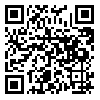Volume 10, Issue 20 (2-2021)
mth 2021, 10(20): 79-93 |
Back to browse issues page
Download citation:
BibTeX | RIS | EndNote | Medlars | ProCite | Reference Manager | RefWorks
Send citation to:



BibTeX | RIS | EndNote | Medlars | ProCite | Reference Manager | RefWorks
Send citation to:
Nosrati Z, Attarzadeh A. (2021). Comparative Approach to the Relationship Between Text and Hand Visual Language in Tahmasebi’s Shahnameh Pictures. mth. 10(20), 79-93. doi:10.52547/mth.10.20.79
URL: http://mth.aui.ac.ir/article-1-1407-en.html
URL: http://mth.aui.ac.ir/article-1-1407-en.html
1- M.A Holder in Handicrafts, Faculty of Art, Soore University, Tehran, Iran. , zahranosrati81@gmail.com
2- Assistant Professor, Faculty of Art, Soore University, Tehran, Iran.
2- Assistant Professor, Faculty of Art, Soore University, Tehran, Iran.
Abstract: (6411 Views)
The painters of Tahmasbi Shahnameh, in order to depict the text full of the story of Shahnameh, tried to convey emotions and excitement to the audience by using the visual language of the hand. Due to the multiplicity of applications of this type of nonverbal communication in different situations, the painter may have undergone changes in parts of her painting under the influence of various factors, such as court order, which is not consistent with the text of the story. The main question in this article was: In presenting the message of the story through the visual language of the hand, what descriptions and shapes have the painters of Shahnameh Tahmasebi chosen to display the text with hand gestures, and how faithful they have been to the text of the book in this way? And the sub-question of the article is: why in some paintings the visual language of “hand” is exaggerated? The main purpose of this research is to identify the painting skills of Tahmasbi Shahnameh artists in using visual hand language and their level of attention to the text. Understanding the creativity in past Iranian painting doubles the importance of this research. This research has been done in a descriptive analytical way, an analysis based on the application of data and based on the images in the Shahnameh through library resources. The results of the study showed that the painters of Tahmasebi’s Shahnameh used hand movements in their paintings to show the emotional scenes of the story, such as victory and defeat, sorrow and regret, dance, surprise and waiting and in this way, they try to arouse the emotions of the reader to get her involved in emotional issues. They have creatively used non-verbal communication to display the text and have succeeded in representing the story and part of the culture of their time. They used it in emotions and repetition in their paintings, and in this way, they presented another part of the ritual of their period in the form of showing the correlation between poetry and painting.
Type of Study: Research |
Subject:
Visual Arts
References
1. احمدیانیپی، محمدهادی و نیکداراصل، محمدحسین (1395). تحلیل ارتباطات غیرکلامی در بوستان سعدی. بوستان ادب، 8 (27)، 210-181.
2. بهنام، مینا؛ قوام، ابوالقاسم و تقوی، محمد (1393). گفتار بیصدا بر زبان بدن در غزلیات شمس. فنون ادبی، سال ششم (11)، 48-33.
3. بیهقی، ابوالفضل محمدبن حسین (1388). تاریخ بیهقی. چاپ چهاردهم، جلد 2، تهران: مهتاب.
4. پولاک، جاکوب ادوارد (1368). سفرنامه پولاک: ایران و ایرانیان. ترجمه کیکاووس جهانداری، چاپ دوم، تهران: خوارزمی.
5. پهلواننژاد، محمدرضا (1386). ارتباطات غیرکلامی و نشانهشناسی حرکات بدن. فصلنامه زبان و زبانشناسی، 3 (6)، 30-13.
6. پیز، آلن (1384). زبان بدن، راهنمای تعبیر حرکات بدن. ترجمه سعیده لرپری زنگنه، چاپ چهارم، تهران: جانان.
7. تاورنیه، ژان باتیست (1389). سفرنامه تاورنیه. ترجمه حمید ارباب شیرانی، چاپ اول، تهران: نیلوفر.
8. جهانگیری، نادر (1370). رفتار غیرکلامی. مجله دانشکده ادبیات و علوم انسانی دانشگاه فردوسی مشهد، 9 (1)، 220-205.
9. چمنآرا، سهراب (1395). گفتار شورانگیز فردوسی. https://library.tebyan.net/fa/170943 بازیابی شده در تاریخ 25 اردیبهشت 1397.
10. حسامزاده، منصور همایون (1389). زبان بدن، بایدها و نبایدها در زبان بدن. چاپ اول، تهران: پورنگ.
11. خسروی، حسین (1397). بازشناسی ویژگیهای سبک هندی. پژوهشهای نقد ادبی و سبکشناسی، 9 (1)، 106-75.
12. خلج امیرحسینی، مرتضی (1389). رموز نهفته در هنر نگارگری. چاپ دوم، تهران: کتاب آبان.
13. دﻫﺨﺪا، ﻋﻠﻲاﮐﺒﺮ (1377). لغتنامه دهخدا. چاپ دوم، جلدهای 3، 9 و 14، تهران: دانشگاه تهران.
14. شرلی، آنتونی و شرلی، رابرت (1362). سفرنامه برادران شرلی. ترجمه آوانس، چاپ اول، تهران: نگاه.
15. شوالیه، ژان و گربران، آلن (1382). فرهنگ نمادها. ترجمه سودابه فضایلی، چاپ دوم، جلد 3، تهران: جیحون.
16. فردوسی، ابوالقاسم (1350). شاهنامه بایسنقری. چاپ اول، تهران: کاخ گلستان.
17. فردوسی، ابوالقاسم (1353). شاهنامه فردوسی به تصحیح ژول مول. ترجمه جهانگیر افکاری، چاپ دوم، تهران: فرانکلین.
18. کریستین سن، آرتور (1374). وضع ملت و دولت و دربار در دوره شاهنشاهی ساسانیان. ترجمه مجتبی مینوی، چاپ اول، تهران: پژوهشگاه علوم انسانی و فرهنگی.
19. محمدزاده، مهدی و ظاهر، عادل (1394). تأثیر شاهنامه طهماسبی در سنت شاهنامهنگاری عثمانی. نگره، 10 (34)، 37-26.
20. مهران، فرهاد (1387). بیت مصور: پیوند متن و نقش در نسخههای شاهنامه. نامه بهارستان، سال هشتم و نهم (13 و 14)، 118103.
21. نیکخو، عاطفه؛ جهانگرد، فرانک و قاسمی، ملیحه (1395). بررسی ویژگی مشترک شعر سبک هندی و مینیاتور اصفهان. پژوهشهای ادبیات تطبیقی، 4 (3)، 108-81.
22. URL 1: https://www.metmuseum.org/art/metpublications/A _Kings_Book_of_Kings_The_Shah _nameh_of_ Shah_Tahmasp (access date: 2018/11/07).
Send email to the article author
| Rights and permissions | |
 |
This work is licensed under a Creative Commons Attribution-NonCommercial 4.0 International License. |







